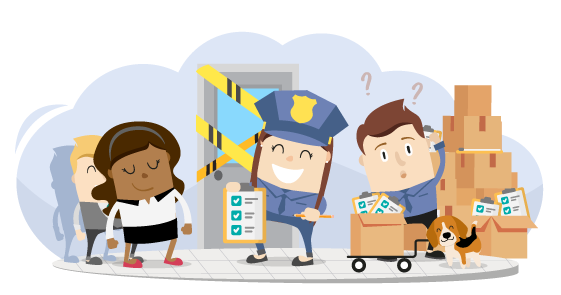Content strategy and gated content: generate and manage leads without a hitch
Nov 23 2021 / 5 min

Are you familiar with the concept of gated content? It’s a type of content that is accessible to users in exchange for their personal information. This clever practice allows you to collect valuable data about your prospects.
However, not all content is suitable to be offered as gated content, also known as “locked” or “protected” content. Is this the right tactic for your marketing strategy? And once you’ve collected your leads, what are the next steps?
Let’s dive deeper into the concept of gated content to explore the key considerations for using it effectively. Learn how this approach can help you capture qualified leads, optimize your conversion strategy, and strengthen your relationship with prospects. Get ready to unlock the secrets of gated content and harness its full potential to reach your marketing goals!
What is gated content, the secret weapon of B2B content marketing?
The principle behind gated content is quite simple: exchange valuable content for an action from curious visitors, usually their contact details (mainly their name and email address). Gated content can take many forms and target different audiences.
This valuable content should be especially relevant to your prospects. Most importantly, present it while minimizing the friction to access it—one of the cornerstones of user experience (a key part of web design). Users must be willing to overcome the hurdle of the information form that stands between them and the content. That’s why the form should be brief and easy to use!
Here are two examples of tactics using gated content and their objectives:
- To add names to your lead database, offer your content via a pop-up or an irresistible landing page. This landing page should simply and effectively convince the user of the benefits of downloading the ebook, checklist, or training they’re interested in.
- Offer gated content exclusively to your clients. Whether it’s accessible via a client portal or a newsletter, your video, tool, or specialized article should help maintain a lasting relationship with them.
“Gated content can transform anonymous visitors into leads, but it can also be a barrier. It’s all about timing and presentation!”
Remember that in an inbound marketing strategy, different types of content should coexist across multiple platforms to serve various objectives. To avoid turning off some users, freely accessible, more general content should live alongside more specialized gated content!
Gated content: brilliant idea or trap in disguise?
While gated content is an effective tactic, you need to keep the following points in mind to unlock its full potential.
- Choose the right format. Your gated content should appeal to your prospects. Ask yourself: what attracts the reader, and is this “magnet” strong enough to make them go through the few steps required to unlock the content? Otherwise, one click is all it takes for them to move on. For example, although case studies are a B2B marketing heavyweight, they might not be the most engaging format for your targets, which brings us to the next point.
- Target the right moment in the buying cycle. This is the heart of the matter: choose the right stage in the customer journey to offer your valuable content in exchange for their information. Too early, and they might not see the value or want to bother filling out the form. Too late, and they might have already found what they were looking for or already made a purchase decision, with or without you!
- Also, offer freely accessible content. Creating content for each stage of the customer journey is essential. Along with gated content, include articles or videos accessible without commitment. This builds your credibility and gives useful content to prospects at the top of your funnel. It’s a win-win!
- Have the resources and time to handle the leads. Who will process them, respond, and follow up? What’s the point of collecting tons of leads if no one on your team can follow up?
Another heads-up: gated content by itself generates little website traffic and has minimal SEO value. Other parts of your content strategy should cover this. Would your content be more useful appearing in Google search results or behind a gate?
If you want to showcase your expertise in another way, there are plenty of options: client training, freely accessible content of all kinds, or even brand awareness strategies!
Also Read: The DNA of successful content marketing: Everything you need to know
5 best practices for successful gated content
Whether your gated content is created from scratch or you decide to gate an existing ebook or white paper, several best practices apply.
- Send the download link by email to get a foot in your prospect’s inbox.
- Use the opportunity to obtain consent to add them to your email list—a great way to grow your newsletter audience.
- Launch a marketing automation sequence—a series of automated actions after they download your content. For example: after 10 days, send another tool; after 20 days, a survey. After 30 days, someone from sales could follow up. Creating gated content isn’t the end goal!
- Measure the data collected. Are the page views meeting your expectations? Are survey responses favorable? This information will help you make necessary adjustments.
- Manage the leads you collect. If you can’t handle a large influx of leads, your gated content investment might go to waste! To help organize your leads, a suitable CRM (Customer Relationship Management) system is a key tool—it also helps measure campaign ROI more easily.
Collected your leads—Now what?
Once you’ve gathered prospects through gated content, it’s crucial to have a clear plan to manage and nurture them effectively. Here are a few key steps:
1. Qualify your leads
Start by assessing the quality and relevance of the leads you’ve acquired. Focus on identifying those most likely to convert into customers based on their engagement and fit with your target audience.
2. Segment your leads
Categorize your leads based on criteria like demographics, interests, behaviours, or buying intent. This segmentation will help personalize your communication and tailor your marketing efforts to meet their specific needs better.
3. Implement lead nurturing campaigns
Develop a systematic lead-nurturing approach to engage and cultivate potential clients over time. This might include targeted and personalized emails, value-added content, exclusive promotions, or invitations to relevant events or webinars. The goal is to build trust, establish credibility, and guide them through the buying journey.
4. Leverage marketing automation
Use automation tools to streamline your efforts and automate your nurturing processes. These tools can help you deliver relevant content, track engagement, and score leads based on their interest and activity level.
5. Analyze and continuously optimize
Monitor the performance of your nurturing campaigns and track key metrics like open rates, click-through rates, conversions, and ROI. Use these insights to identify what works best and make data-driven adjustments to improve your nurturing efforts.
6. Align with sales
Ensure effective communication and collaboration between your marketing and sales teams. Share insights about leads, provide relevant information, and coordinate your efforts to ensure a smooth transition when leads are ready to make a purchase decision.
By following these steps, you can effectively manage your leads and maximize your chances of turning them into loyal customers. Remember: lead management is an ongoing process, and success depends on continuously refining your approach based on data and insights.
Gated content can be a valuable tactic in your marketing strategy, but it’s important to approach it with careful planning and strategic thinking. By choosing the right format, targeting the appropriate stage in the buying cycle, providing a balance of freely accessible content, ensuring you have the resources to manage leads, and integrating it into your overall content strategy, you can unlock the full potential of gated content.
Don’t forget: the goal is to strike a balance between collecting valuable prospect information and offering quality content that resonates with your audience. Gated content should be one piece of your broader content marketing efforts, complemented by other tactics aimed at generating website traffic, boosting SEO, and building brand awareness.
Ultimately, success lies in understanding your target audience’s preferences, needs, and motivations. By delivering relevant, high-quality content and offering a seamless user experience, you can build trust, nurture relationships, and drive conversions.
So, when considering gated content, keep these best practices in mind and tailor your approach to the specific demands of your industry, audience, and business goals. With a well-executed strategy, you can leverage gated content to generate engagement, capture leads, and achieve your marketing objectives.
And if you need help weighing the pros and cons of gated content—or if you’re drowning in leads—don’t hesitate to call in our savvy strategists!
You may also like

B2B Brands: Why Dare to Use Emotion and Creativity
We all know the contrast: a B2C ad that moves us to tears or makes us laugh out loud… and a B2B ad we skim through,[...]
Branding
Oct 2, 2025
/3 min

Brand Gravity: How to Attract B2B Clients Without Chasing Them
In a B2B world flooded with information, buyers move far along their journey before ever speaking to a sales repres[...]
Strategy
Sep 22, 2025
/3 min

Bill C-59 and B2B Marketing: What to Expect
Trust has become one of the most valuable currencies in B2B marketing. It influences buying decisions, customer loy[...]
Branding
Sep 8, 2025
/3 min
